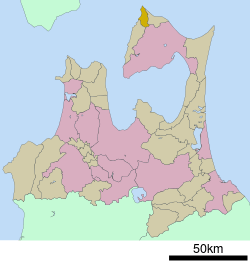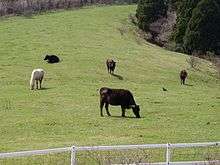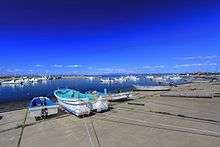Ōma
Ōma (大間町, Ōma-machi) is a town located in Aomori, Japan. In 2020, the town had an estimated population of 5,155, and a population density of 99 per square kilometre (260/sq mi),in 2,497 households.[1] The total area of the town is 52.06 square kilometres (20.10 sq mi).[2]
Ōma 大間町 | |
|---|---|
Town | |
 Sunrise in Ōma | |
Flag  Seal | |
 Location of Ōma in Aomori Prefecture] | |
 Ōma | |
| Coordinates: 41°31′36.3″N 140°54′26.4″E | |
| Country | Japan |
| Region | Tōhoku |
| Prefecture | Aomori |
| District | Shimokita |
| Area | |
| • Total | 52.06 km2 (20.10 sq mi) |
| Population (March 31, 2020) | |
| • Total | 5,155 |
| • Density | 99/km2 (260/sq mi) |
| Time zone | UTC+9 (Japan Standard Time) |
| City symbols | |
| - Tree | Japanese black pine |
| - Flower | Rosa rugosa |
| - Bird | Common gull |
| Phone number | 0175-37-2111 |
| Address | 104 Ōma, Ōma-machi, Shimokita-gun, Aomori 039-4692 |
| Website | Official website |
Geography
Ōma occupies the northwestern coastline of Shimokita Peninsula, facing the Tsugaru Strait. Cape Ōmazaki (大間崎) is the northernmost point on the island of Honshū. Much of the town is within the limits of the Shimokita Hanto Quasi-National Park. In 2002, the Ministry of the Environment classified some tidal flats of the Ōma shoreline as one of the 500 Important Wetlands in Japan particularly for its biodiversity of marine flora, especially several varieties of kelp.[3]
Climate
The town has a climate characterized by cool short summers and long cold winters with strong winds (Köppen climate classification Cfa). The average annual temperature in Ōma is 9.5 °C. The average annual rainfall is 1205 mm with September as the wettest month. The temperatures are highest on average in August, at around 22.3 °C, and lowest in January, at around -1.8 °C.[4]
Demographics
According to Japanese census data,[5] the population of Ōma has declined since 1960.
| Year | Pop. | ±% |
|---|---|---|
| 1920 | 4,077 | — |
| 1930 | 5,396 | +32.4% |
| 1940 | 6,054 | +12.2% |
| 1950 | 7,217 | +19.2% |
| 1960 | 7,983 | +10.6% |
| 1970 | 7,673 | −3.9% |
| 1980 | 7,624 | −0.6% |
| 1990 | 7,125 | −6.5% |
| 2000 | 6,566 | −7.8% |
| 2010 | 6,340 | −3.4% |
History
The area around Ōma was inhabited by the Emishi people until the historical period. During the Edo period, it was controlled by the Nambu clan of Morioka Domain. During the post-Meiji restoration establishment of the modern municipalities system on 1 April 1889, Ōoku Village was proclaimed from the merger of Ōma hamlet with neighboring Okudo hamlet. It was renamed Ōma Town on 3 November 1942.
Ōma has been a popular location setting for movies and television dramas. It was the setting for the 1983 movie Gyōei no mure (魚影の群れ) starring Ken Ogata. In 2000, Ōma was the setting for an NHK television series Watashi no Aoi Sora (私の青空) starring Tabata Tomoko. This was followed by another fictional series Maguro (マグロ) on TV Asahi starring Tetsuya Watari in 2007.
Government
Ōma has a mayor-council form of government with a directly elected mayor and a unicameral town council of ten members. Ōma is part of Shimokita District which, together with the city of Mutsu, contributes three members to the Aomori Prefectural Assembly. In terms of national politics, the city is part of Aomori 1st district of the lower house of the Diet of Japan.
Economy



The economy of Ōma was traditionally heavily dependent on commercial fishing. The town was famous for having the "black diamond" of tuna, which are caught in the traditional manner by hand in two-person boats, and sold under the "Ōma" registered brand. One Ōma tuna was sold at a record-high 333.6 million yen in January 2019.[6] Other seafood products include sea urchin roe, konbu and squid.[7]
The town is the site of a nuclear power plant, the Ōma Nuclear Power Plant, which will be unique in its use of MOX fuel when it comes on line.[8]
Education
Ōma has two public elementary schools and two public middle schools operated by the town government, and one public high school operated by the Aomori Prefectural Board of Education.
Transportation
Railway
- The town has no passenger railway service.
Highway
Local attractions
- Ōmazaki, northernmost point on the island of Honshū
- Ōmazaki Lighthouse, one of the “50 Lighthouses of Japan”
- Ōma Onsen, hot spring resort
- Akaishi Beach
Noted people from Ōma
- Hiroshi Izumi – silver medalist in judo at the 2004 Summer Olympics
References
- Ōma Town official statistics
- 詳細データ 青森県大間町. 市町村の姿 グラフと統計でみる農林水産業 (in Japanese). Ministry of Agriculture, Forestry and Fisheries. 2016. Retrieved 13 July 2017.
- "500 Important Wetlands in Japan". No. 62 Nearshore Waters of Oma-zaki in Shimokita-hanto. The Ministry of the Environment, Japan. 2002. Retrieved 4 March 2017.
- Ōma climate data
- Ōma population statistics
- "Bluefin tuna sells for record $3.1 million at Tokyo fish market, but scarcity clouds celebration". Washington Post. 5 January 2019. Retrieved 7 February 2019.
- Fackler, Martin (September 19, 2009). "Tuna Town in Japan Sees Falloff of Its Fish". New York Times. Retrieved 22 November 2015.
- Watanabe, Chisaki, and Stuart Biggs, Bloomberg L.P., "Rejecting ¥160 million, nuke holdout left with reactor view", Japan Times, 15 July 2011, p. 3.
- "International Exchange". List of Affiliation Partners within Prefectures. Council of Local Authorities for International Relations. Retrieved 21 November 2015.